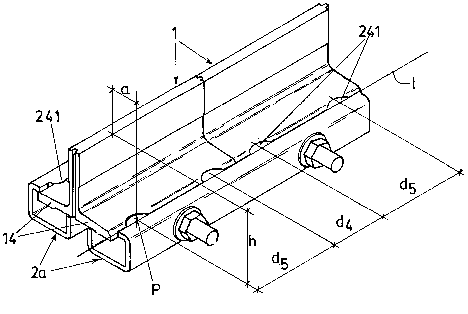Some of the information on this Web page has been provided by external sources. The Government of Canada is not responsible for the accuracy, reliability or currency of the information supplied by external sources. Users wishing to rely upon this information should consult directly with the source of the information. Content provided by external sources is not subject to official languages, privacy and accessibility requirements.
Any discrepancies in the text and image of the Claims and Abstract are due to differing posting times. Text of the Claims and Abstract are posted:
| (12) Patent Application: | (11) CA 2552764 |
|---|---|
| (54) English Title: | QUICK-COUPLING/MOUNTING SYSTEM FOR ELEVATOR GUIDES |
| (54) French Title: | SYSTEME D'ASSEMBLAGE/DE MONTAGE RAPIDE POUR GUIDES D'ASCENSEUR |
| Status: | Deemed Abandoned and Beyond the Period of Reinstatement - Pending Response to Notice of Disregarded Communication |
| (51) International Patent Classification (IPC): |
|
|---|---|
| (72) Inventors : |
|
| (73) Owners : |
|
| (71) Applicants : |
|
| (74) Agent: | ROBIC AGENCE PI S.E.C./ROBIC IP AGENCY LP |
| (74) Associate agent: | |
| (45) Issued: | |
| (86) PCT Filing Date: | 2005-01-21 |
| (87) Open to Public Inspection: | 2005-08-04 |
| Availability of licence: | N/A |
| Dedicated to the Public: | N/A |
| (25) Language of filing: | English |
| Patent Cooperation Treaty (PCT): | Yes |
|---|---|
| (86) PCT Filing Number: | PCT/ES2005/000025 |
| (87) International Publication Number: | ES2005000025 |
| (85) National Entry: | 2006-07-06 |
| (30) Application Priority Data: | ||||||||||||
|---|---|---|---|---|---|---|---|---|---|---|---|---|
|
The invention relates to a quick-coupling/mounting system for elevator guides,
in which each guide (1) comprises a central plate (13) and wings (14) bearing
machined segments (141) which are disposed around pre-defined connecting
points (P). The inventive system comprises connecting plates (2) which are
divided into two plate parts (2a) which can move on clamping means (2b), (21),
(22). According to the invention, the clamping means are mounted to the
aforementioned plate parts (2a) and, when the parts are moved closer together,
the clamping means clamp said parts (2a) laterally against the wings (14). In
addition, each plate part (2a) is equipped with aligning elements (3), (241)
which are centred on, and fitted together with the above-mentioned machined
segments (141) at the connecting points (P) of the wings (14). The invention
can be used for the production of elevator guides.
L'invention concerne un système d'assemblage/de montage rapide pour des guides d'ascenseur. Chaque guide (1) comprend une âme (13) et des ailes (14) qui comportent des parties usinées (141) disposées autour de points d'assemblage (P) prédéfinis. Des plaques d'assemblage (2) structurées en deux parties de plaque (2a) peuvent se déplacer sur des moyens de serrage (2b), (21), (22). Ces moyens de serrage sont montés sur lesdites parties de plaque (2a) et, lorsque celles-ci sont rapprochées l'une de l'autre, lesdits moyens de serrage serrent latéralement lesdites parties de plaque contre les ailes (14). Des éléments d'alignement (3), (241) sont disposés dans chaque partie de plaque (2a), ces éléments étant centrés sur les pièces usinées (141) et montés sur celles-ci au niveau de points d'assemblage (P) des ailes (14). L'invention est mise en application dans la production de guides d'ascenseur.
Note: Claims are shown in the official language in which they were submitted.
Note: Descriptions are shown in the official language in which they were submitted.

2024-08-01:As part of the Next Generation Patents (NGP) transition, the Canadian Patents Database (CPD) now contains a more detailed Event History, which replicates the Event Log of our new back-office solution.
Please note that "Inactive:" events refers to events no longer in use in our new back-office solution.
For a clearer understanding of the status of the application/patent presented on this page, the site Disclaimer , as well as the definitions for Patent , Event History , Maintenance Fee and Payment History should be consulted.
| Description | Date |
|---|---|
| Application Not Reinstated by Deadline | 2009-01-21 |
| Time Limit for Reversal Expired | 2009-01-21 |
| Inactive: IPRP received | 2008-02-05 |
| Deemed Abandoned - Failure to Respond to Maintenance Fee Notice | 2008-01-21 |
| Inactive: Cover page published | 2006-09-14 |
| Letter Sent | 2006-09-11 |
| Inactive: Notice - National entry - No RFE | 2006-09-11 |
| Application Received - PCT | 2006-08-17 |
| National Entry Requirements Determined Compliant | 2006-07-06 |
| Application Published (Open to Public Inspection) | 2005-08-04 |
| Abandonment Date | Reason | Reinstatement Date |
|---|---|---|
| 2008-01-21 |
The last payment was received on 2006-12-20
Note : If the full payment has not been received on or before the date indicated, a further fee may be required which may be one of the following
Patent fees are adjusted on the 1st of January every year. The amounts above are the current amounts if received by December 31 of the current year.
Please refer to the CIPO
Patent Fees
web page to see all current fee amounts.
| Fee Type | Anniversary Year | Due Date | Paid Date |
|---|---|---|---|
| Basic national fee - standard | 2006-07-06 | ||
| Registration of a document | 2006-07-06 | ||
| MF (application, 2nd anniv.) - standard | 02 | 2007-01-22 | 2006-12-20 |
Note: Records showing the ownership history in alphabetical order.
| Current Owners on Record |
|---|
| S.A. DE VERA (SAVERA) |
| Past Owners on Record |
|---|
| JESUS SANZ GAMBOA |